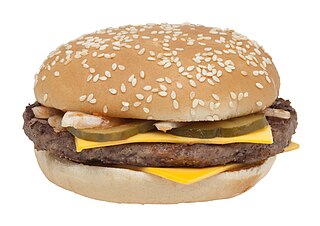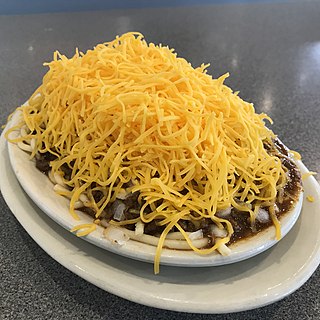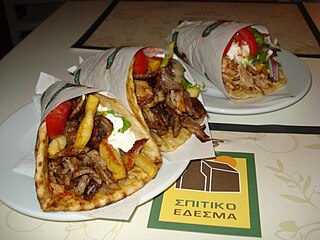Related Research Articles

Midwestern cuisine is a regional cuisine of the American Midwest. It draws its culinary roots most significantly from the cuisines of Central, Northern and Eastern Europe, and Indigenous cuisine of the Americas, and is influenced by regionally and locally grown foodstuffs and cultural diversity.

A hamburger or simply burger is a food consisting of fillings—usually a patty of ground meat, typically beef—placed inside a sliced bun or bread roll. Hamburgers are often served with cheese, lettuce, tomato, onion, pickles, bacon, or chilis; condiments such as ketchup, mustard, mayonnaise, relish, or a "special sauce", often a variation of Thousand Island dressing; and are frequently placed on sesame seed buns. A hamburger patty topped with cheese is called a cheeseburger.

Australian cuisine is the food and cooking practices of Australia and its inhabitants. Australia has absorbed culinary contributions and adaptations from various cultures around the world, including British, European, Asian and Middle Eastern.

Satay, or sate in Indonesian spelling, is a Southeast Asian form of kebab made from seasoned, skewered and barbecued meat, served with a sauce.

Chili con carne, meaning "chili with meat", is a spicy stew containing chili peppers, meat, tomatoes, and often pinto beans or kidney beans. Other seasonings may include garlic, onions, and cumin. The dish originated in northern Mexico.

Fried rice is a dish of cooked rice that has been stir-fried in a wok or a frying pan and is usually mixed with other ingredients such as eggs, vegetables, seafood, or meat. It is often eaten by itself or as an accompaniment to another dish. Fried rice is a popular component of East Asian, Southeast Asian and certain South Asian cuisines, as well as a staple national dish of Indonesia. As a homemade dish, fried rice is typically made with ingredients left over from other dishes, leading to countless variations. Fried rice first developed during the Sui Dynasty in China.

Pastrami is a food originating from Romania usually made from beef brisket. Later recipes use lamb, pork, chicken or turkey. The raw meat is brined, partially dried, seasoned with herbs and spices, then smoked and steamed. Like corned beef, pastrami was originally created as a way to preserve meat before the invention of refrigeration. One of the iconic meats of Eastern European cuisine as well as American Jewish cuisine and New York City cuisine, hot pastrami is typically served at delicatessen restaurants on sandwiches such as the pastrami on rye.

A chili dog is a hot dog served in a bun and topped with a meat sauce, such as chili con carne. Additional toppings may include cheese, onions, and mustard. The style has multiple regional variations in the United States, many calling for specific and unique sauce ingredients, types of hot dogs, or types of buns and referred to regionally under region-specific names.

Cincinnati chili is a Mediterranean-spiced meat sauce used as a topping for spaghetti or hot dogs ("coneys"); both dishes were developed by immigrant restaurateurs in the 1920s. In 2013, Smithsonian named one local chili parlor one of the "20 Most Iconic Food Destinations in America". Its name evokes comparison to chili con carne, but the two are dissimilar in consistency, flavor, and serving method; Cincinnati chili more closely resembles Greek pasta sauces and spiced-meat hot dog topping sauces seen in other parts of the United States.

Chicharrón is a dish generally consisting of fried pork belly or fried pork rinds. Chicharrón may also be made from chicken, mutton, or beef.

Different areas of the world have local variations on the hot dog, in the type of meat used, the condiments added, and its means of preparation.

The cuisine of New Jersey is derived from the state's long immigrant history and its close proximity to both New York City and Philadelphia. Due to its geographical location, New Jersey can generally be divided by New York City cuisine in the northern and central parts of the state and Philadelphia cuisine in the southern parts. Restaurants in the state often make use of locally grown ingredients such as asparagus, blueberries, cranberries, tomatoes, corn, and peaches. New Jersey is particularly known for its diners, of which there are approximately 525, the most of any state. Various foods invented in the state, such as the pork roll, and salt water taffy, remain popular there today.

Israeli cuisine primarily comprises dishes brought from the Jewish diaspora, and has more recently been defined by the development of a notable fusion cuisine characterized by the mixing of Jewish cuisine and Arab cuisine. It also blends together the culinary traditions of the various diaspora groups, namely those of Middle Eastern Jews with roots in Southwest Asia and North Africa, Sephardi Jews from Iberia, and Ashkenazi Jews from Central and Eastern Europe.

A slopper is a cheeseburger served smothered in red chile or green chile or chili sauce. Sloppers generally include grilled buns and are often topped with freshly chopped onions and sometimes french fries. They are typically eaten with a fork and a knife or spoon. The slopper is served in restaurants and taverns in the Pueblo and Colorado Springs area of Colorado. Versions of the slopper are also served throughout the rest of Colorado and parts of the United States.
McDonald's Corporation is the world's largest chain of fast food restaurants, serving around 68 million customers daily in 119 countries. McDonald's traces its origins to a 1940 restaurant in San Bernardino, California. After expanding within the United States, McDonald's became an international corporation in 1967, when it opened a location in Richmond, British Columbia, Canada. By the end of the 1970s, McDonald's restaurants existed in five of the Earth's seven continents; an African location came in 1992 in Casablanca, Morocco.

Padang dish or Minangkabau dish is the cuisine of the Minangkabau people of West Sumatra, Indonesia. It is among the most popular cuisines in Maritime Southeast Asia. It is known across Indonesia as Masakan Padang after Padang, the capital city of Western Sumatra province. It is served in restaurants mostly owned by perantauan (migrating) Minangkabau people in Indonesian cities. Padang food is ubiquitous in Indonesian cities and is popular in neighboring Malaysia and Singapore.

Greek-American cuisine is the cuisine of Greek Americans and their descendants, who have modified Greek cuisine under the influence of American culture and immigration patterns of Greeks to the United States. As immigrants from various Greek areas settled in different regions of the United States and became "Greek Americans," they carried with them different traditions of foods and recipes that were particularly identified with their regional origins in Greece and yet infused with the characteristics of their new home locale in America. Many of these foods and recipes developed into new favorites for town peoples and then later for Americans nationwide. Greek-American cuisine is especially prominent in areas of concentrated Greek communities, such as Astoria, Queens and Tarpon Springs, Florida.

Nem nướng is Vietnamese grilled pork sausage or grilled meatballs, and a popular Vietnamese food item, sometimes served as an individual appetizer or snack, or served with rice noodles or rice as a main course. Nem nướng is a specialty of Khánh Hòa Province . Nem nướng is a rustic dish, originating from Ninh Hoa, a northern district of Khanh Hoa province, about 30 km from the coastal city.
References
- ↑ "How the Fat Boy burger became a Winnipeg icon". CBC.ca. Retrieved May 14, 2021.
- ↑ Sanderson, David (April 14, 2019). "In a city with no shortage of Greek burger joints, Dairy Delight is home to a dynasty". Winnipeg Free Press. Retrieved May 15, 2021.
- ↑ "10 tastes of Winnipeg". Canadian Living. January 16, 2012. Retrieved May 15, 2021.
- ↑ "Aug 2008: Who you callin' fat?". Winnipeg Free Press. August 23, 2008.
- ↑ "The Winnipeg Fatboy". Eat This Town. August 25, 2016. Retrieved May 14, 2021.
- ↑ "Junior's:More than just Fat Boys". Peg City Grub. Retrieved May 14, 2021.
- ↑ "Manitoba Food History Project 'trucks along'". Manitoba Co-operator. November 12, 2019. Retrieved May 15, 2021.
